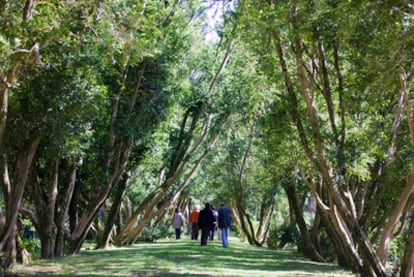Greetings from Captain Nemo
Galician isle aims to become global reference point for science and the arts, despite checkered Civil War past
If these rocks, if these trees, if these waves could talk, they would tell stories of pirates, of knights templar, of monks and soldiers, of fantastic submarines and sturdy galleons, of monasteries and orphanages, of repression, disease and death, of science, magic and thought. They would talk about 10 centuries of history.
The small, lush island of San Simón navigates time in its cove at the far end of Vigo's estuary, within the city bounds of Redondela. The latest chapter in its busy history is its management by the Illa de San Simón Foundation, which aims to turn it into a global reference point for science, art and culture through a project known as Isla del Pensamiento, or Isle of Thought.
The refurbished facilities now host scientific events such as Neuromagic, which brought together neurologists and magicians to explore the limits of human perception; #NeThinking, which convened internet and social network experts, or Testimonies of the Future, a scientific reflection on what the world will look like in half a century. Besides that, San Simón hosts concerts and other cultural events.
When the boat approaches San Simón, visitors may be startled to find a statue sticking out of the water: it is a likeness of Captain Nemo, the lord of the Nautilus, the famous submarine described in Jules Verne's timeless novel 20,000 Leagues Under the Sea. When the tide is low two inanimate scuba divers emerge at his feet, then disappear again with the rising waters. The French novelist was familiar with this bewitching island and he included it in some scenes from the book.
Days of infamy
Once on land, it becomes evident that this is not in fact one island but two: the island of San Simón is joined to the isle of San Antón by a small bridge. This double perimeter may be covered on foot in 20 minutes, which gives a sense of how small this place is: 250 meters wide by 84 long. Here and there, standing among the eucalyptus, cedars, oak and camelias, or next to the piers, are sculptures of famous Galician artists.
From 1838, the island functioned as an isolation center for sailors coming in from the other side of the Atlantic Ocean who were quarantined to prevent infectious diseases from spreading across the peninsula. San Simón also knew days of infamy during the Spanish Civil War and postwar period, when it housed a concentration camp. Between 1936 and 1943, an estimated 6,000 prisoners were held here in precarious conditions, and some were executed by the rebels. In 1948 it became a summer residence for Franco's guards, and between 1955 and 1963 it served as an orphanage for sailors' children.

Tu suscripción se está usando en otro dispositivo
¿Quieres añadir otro usuario a tu suscripción?
Si continúas leyendo en este dispositivo, no se podrá leer en el otro.
FlechaTu suscripción se está usando en otro dispositivo y solo puedes acceder a EL PAÍS desde un dispositivo a la vez.
Si quieres compartir tu cuenta, cambia tu suscripción a la modalidad Premium, así podrás añadir otro usuario. Cada uno accederá con su propia cuenta de email, lo que os permitirá personalizar vuestra experiencia en EL PAÍS.
¿Tienes una suscripción de empresa? Accede aquí para contratar más cuentas.
En el caso de no saber quién está usando tu cuenta, te recomendamos cambiar tu contraseña aquí.
Si decides continuar compartiendo tu cuenta, este mensaje se mostrará en tu dispositivo y en el de la otra persona que está usando tu cuenta de forma indefinida, afectando a tu experiencia de lectura. Puedes consultar aquí los términos y condiciones de la suscripción digital.
Últimas noticias
A floating school teaches children how to save Lake Atitlán
Pablo Escobar’s hippos: A serious environmental problem, 40 years on
From Andorra to Gibraltar, a black market for Ozempic exploits its success: ‘They’re the most sought-after products in the world’
The brief rise and retreat of Generation Z in Mexico
Most viewed
- Why we lost the habit of sleeping in two segments and how that changed our sense of time
- Charles Dubouloz, mountaineering star, retires at 36 with a farewell tour inspired by Walter Bonatti
- Venezuela faces its most tense Christmas yet
- CBS in crisis after pulling a report on Trump’s deportations to El Salvador (which later leaked online)
- Bukele clan fumes over investigation exposing their new wealth








































